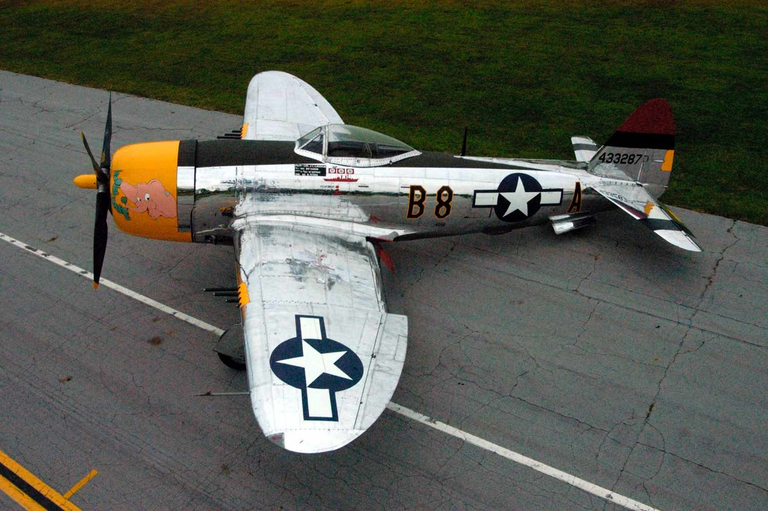Heeeyho Readers! Coming by with an update from the project!
Dealing with limited resources is the epitome of this project. First, le dumb me cracked the handlebar in a crash, which drained resources meant for the now-postponed front fork. The later-in-the-list mishap: within a week our dog managed to chew my camera's SD card and a GPS unit. Bummer! More resources going into stuff that shouldn't...
Project is moving though. Limping, but advancing. I managed to restore a set of v-brakes from the early 2000's (perks of storing old parts from previous bikes). I also received some minor parts from China and more brake parts are coming (read further). The whole thing feels like assembling those magazine-distributed ship/car/airplane model kits. Did you have those around you? Modeling magazines used to issue parts each week that, in the end, completed the model. Yeah, miss a week and you're screwed.
Here's the project update with a parts table and costs so far.
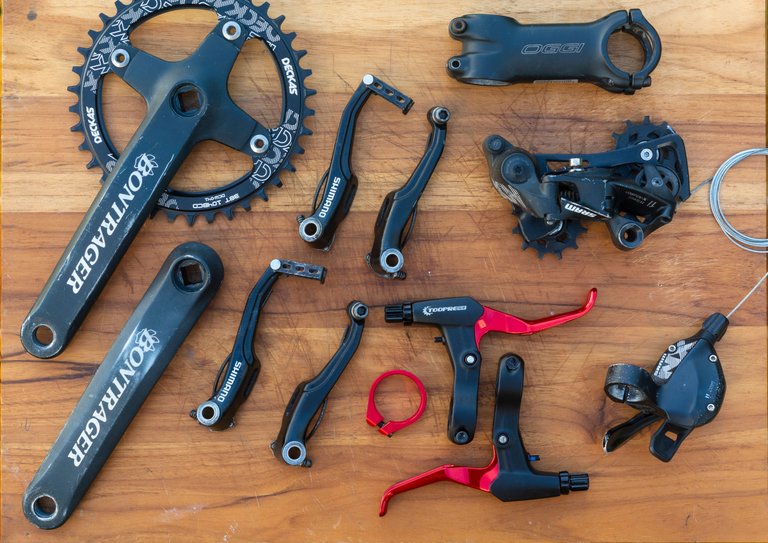
As you imagined, bicycles have dozens of parts. Keeping a list of parts in a table is the best way to manage a bicycle project (or any project). Like Jack the ripper, dividing the bicycle in sections helps in keeping perspective ahead. Sections are:
- Transmission (shifter, cranks, bottom-bracket, chainring, chain, derailleur, casette, cable and cable housing, pedals)
- Brakes (brake levers, cables and cable housing, brake pads, brake arms)
- Handling (headset, handlebar, stem)
- Body (frame, forks)
- Seat (saddle, seat post, seat clamp)
- Wheels and Tires
Latest additions
I presented the wheels in the first post. Today is more of a general view of what's stored for this project. Directly from China arrived a pair of beautiful aluminum brake levers — red is gonna match the theme planned for this bicycle. Also see below the v-brakes.
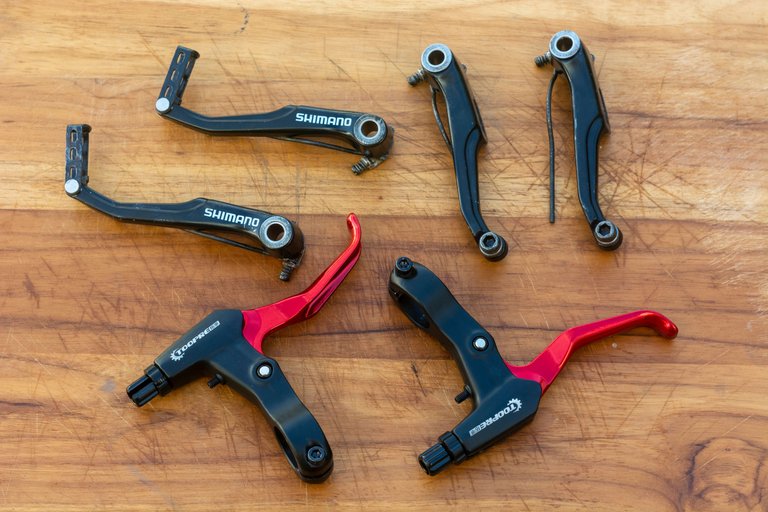
A red seatpost clamp arrived in the same order. I guess these are going to be the only red parts; more red parts would drive attention away form other details. I'd planned to use red handlebar tape, but, at this point, dark beige is gonna look cooler. Let's see.

Chinese parts are incredibly well made for the price. Sure, there's junk amidst quality stuff, though reviews are plenty to guide our decisions. Stick to branded stuff and everything should be fine.
Above you can also see the stem (part that fixes the handlebar to the fork). I already had that stem from the mountain-bike, now gotta wait and see if it'll work for my fit.
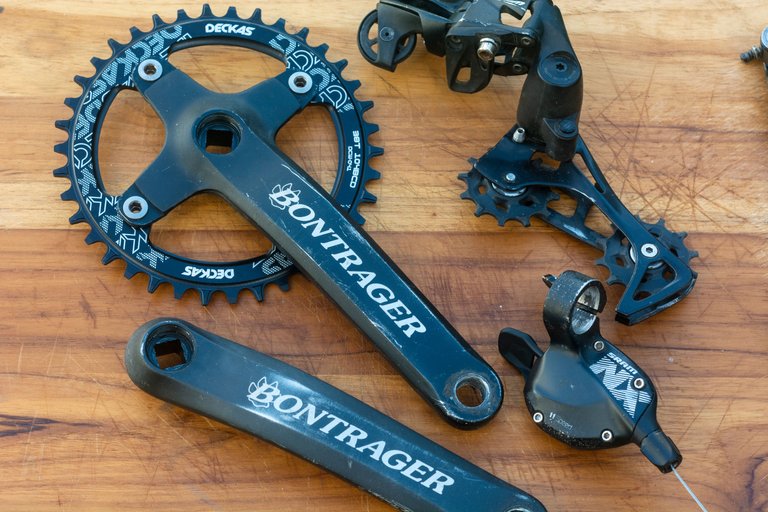
Same for the groupset. The derailleur, shifter, and cassette came from the mountain-bike after upgrading from 11 to 12 speed. The crank arms are from the parts box, from an early 2000's Trek. The 38 teeth narrow-wide chainring is from China. I'm pretty sure 38 is not gonna be enough for higher speeds, but testing is the only way to assure.
Square-tapered bottom-brackets/cranks are quite outdated, although I see no reason to upgrade once those parts were already available.
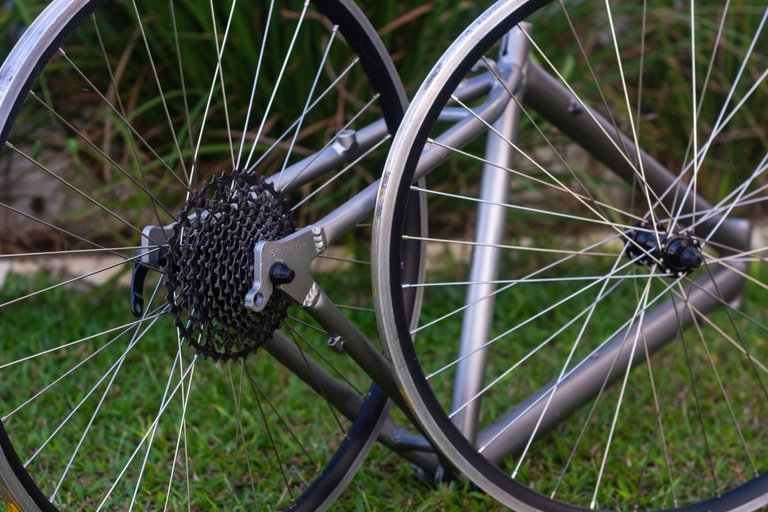
Remember the wheels? They looks so freaking awesome with the 11-speed cassette installed. Quite absurd to think those rims are twenty years old. What a difference a new paintjob makes!
The frame
I never showed the frame in this blog. A new paintjob is on the plans. Going for a WWII-inspired theme. Airplane, maybe. WWII-era planes are the best in terms of paintjobs; love them all, Spirfires and P-47s mostly.
This is a 1993 Two Hard Splendid, one of the first Brazilian-made aluminum frames. Not the lightest, but rugged as fuck. I guess they didn't quite figure out the aluminum tech back then, so every tube is over-engineered. It's gonna be a fun build.
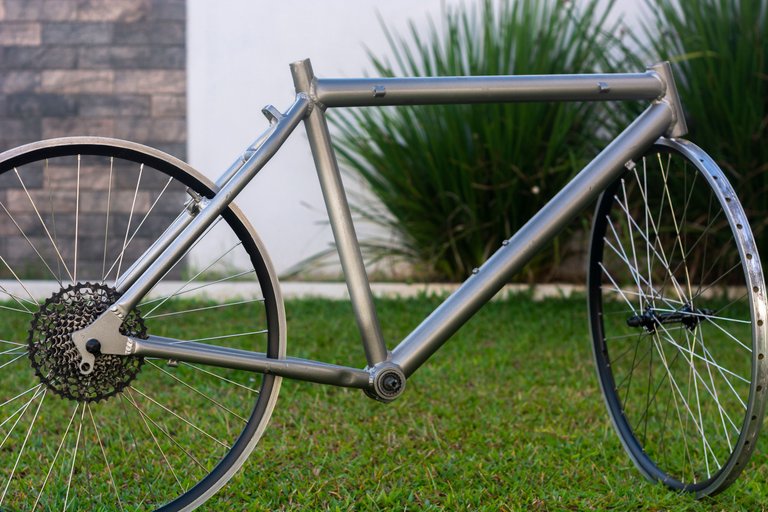
Monster-cross builders generally opt for 90's cromoly frames because those are easier to modify. Early Specialized Rockhopper are great examples. There's no rule though. The fun thing about monster-cross bicycles is exactly the uniqueness and the uncertainty — you fit whatever parts you have laying around.
The only issue is frame sizes. I'm still trying to figure out the whole geometry stuff to make the bicycle as close as possible to a gravel bicycle. The above frame is 18", which is kinda small for me (I use 19", aka Large).
Wheels are 26", as opposed to the more popular 700c on gravel bikes. Why using 26s? Because it's fun! It wouldn't be a Frankenstein bicycle without parts that feel wrong.
Parts List
Well, those are the parts I have so far. Incoming are minor braking items such as brake pads and repair kit. Without the later, the braking system is complete. Check the table below.
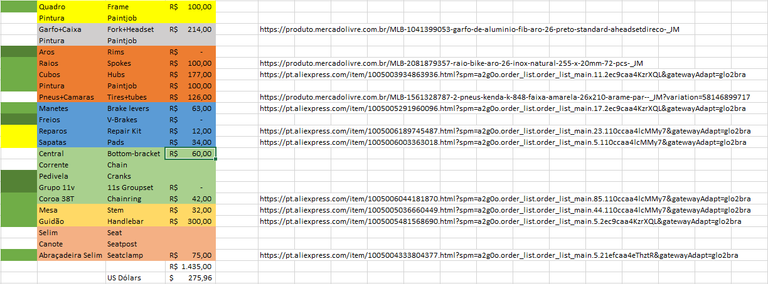
Lemme breakdown the far left column:
- Light green: Bought parts ready to assemble
- Dark green: Ready-to-assemble parts that I already had
- Yellow: Incoming parts
- No-colour: Parts I still need
Prices in the right column are in Brazilian Real (1 USD = ~5,15 Real), so divide by 5 and there you have it. Parts marked (-) I got for free; non-priced parts are not yet quoted. The total sum of 275 dollars account for parts I already bought and parts to be bought (No-colour on the left), but are quoted.
I'm saving up for the fork + headset (~ 50 USD), to allow me to begin the new paintjob. Both need to be prepared/painted together. Tires would be awesome too; can't wait to see the wheels complete. Our dog could cooperate and stop eating stuff {laughs}.
Anyways. That's what I've got for today. I hope that you feel inspired to start a project too; doesn't need to be a bicycle.
Until next time.
Peace.
If you enjoyed this post consider leaving your upvote for a hot coffee.
Find me on Twitter: https://twitter.com/mrprofessor_
~Love ya all,
Disclaimer: The author of this post is a convict broke backpacker, who has travelled more than 10.000 km hitchhiking and more than 5.000 km cycling. Following him may cause severe problems of wanderlust and inquietud. You've been warned.





